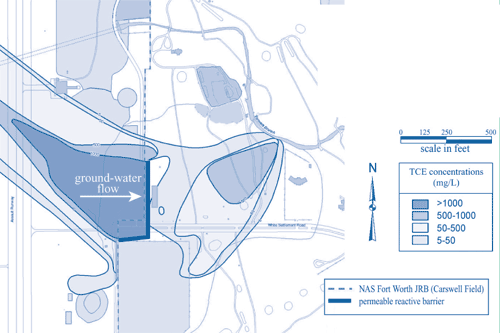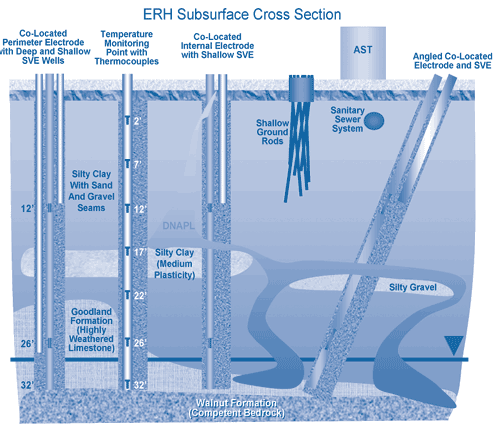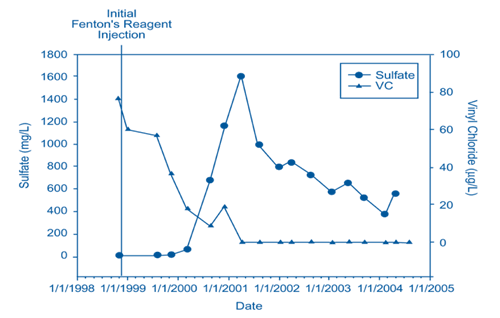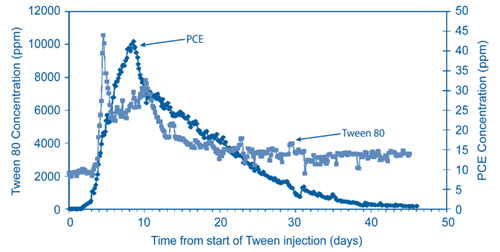- Biopolymer Slurry Proves Effective for PRB Installation and Performance
- Air Force Uses Electrical Resistance Heating for TCE Source Removal and Plume Reduction
- Accelerated Cleanup Follows Fenton's ISCO and Substrate Addition
- SEAR and Bioaugmentation Demonstrated for PCE Source Treatment and Plume Control
Biopolymer Slurry Proves Effective for PRB Installation and Performance
In April 2002, the Air Force Center for Environmental Excellence (AFCEE) constructed a 1,100-foot long, zero-valent iron (ZVI) permeable reactive barrier (PRB) at the former Carswell Air Force Base in Texas to demonstrate the feasibility of using this technology to degrade chlorinated ethenes in ground water. The untreated ground water contains trichloroethene (TCE) in concentrations reaching 1,500 µg/L, cis-1,2-dichloroethene (DCE) in excess of 480 µg/L, and trace amounts of trans-1,2-DCE and vinyl chloride. Ground water flowing through the PRB experiences a 99% reduction in TCE concentrations, resulting in an effluent value of 5µg/L.
The PRB consists of a 2-foot thick, equal-proportion mixture of ZVI and sand that extends from a depth of 2-3 feet above the high water table to the top of a bedrock aquitard. The top of bedrock exists at an average depth of 38 feet, and the saturated thickness of the surficial aquifer is 10-12 feet. Preliminary evaluation of the treatment area and a focused feasibility study considered various PRB configurations prior to construction. To prevent the plume from bypassing the PRB, the selected design entailed a single, continuous trench housing a 300- and an 800-foot long section of reactive material.
Use of guar gum as a biodegradable biopolymer slurry was an innovative technique for shoring the trench sidewalls. The slurry method allowed for rapid installation of the PRB within a small area and in a "zigzag" pattern to accommodate a landfill, an overhead power line, a high-pressure water line, and a maintenance building. Liquid shoring also eliminated the need for deeper (up to 20 feet) and more costly trenching. After the trench was backfilled, the guar gum slurry was degraded by adding a liquid enzyme breaker within the ZVI, and recirculating the ground water through the trench using a system of 22 recirculation wells for a minimum of three pore volumes. Soil microbes completed the guar gum degradation process.
Quarterly sampling is conducted at four transects across the PRB, each consisting of an upgradient well, a downgradient well, and a well within the reactive media. Analytical results demonstrate that the PRB has maintained a TCE removal efficiency of 99.5% since sampling began in June 2002. Based on an estimated ground-water velocity of 2 ft/day, it is estimated that the PRB removes 980 pounds of TCE each year. Results also indicate that the PRB is reducing TCE concentrations in the distant and downgradient residual plume (Figure 1) from a maximum of 2,500 µg/L to less than 1,000 µg/L.

Downgradient concentrations of cis-1,2-DCE also have decreased, but not to the same extent. Treatment efficiencies for cis-1,2-DCE and vinyl chloride have varied over time and among transects within a single sampling event. Monitoring suggests that these variations are attributable to the activity of anaerobic microbial populations (Dehalococcoides) that were enhanced by the use of biopolymer slurry. These findings suggest that the high rate of TCE removal is due to not only to abiotic degradation by the ZVI but by anaerobic biodegradation as well.
Ground-water elevations within and adjacent to the PRB are measured as part of each quarterly monitoring event. Ground-water flow in the vicinity of the PRB was disrupted temporarily during construction due to the liquid shoring, but contouring of ground-water elevations demonstrated that flow returned to normal by the second monitoring event.
Several lessons were learned during construction of the PRB. When the mixing of reactive media in small, skid-mounted mixers was found to be time-consuming, a cement mixer was employed. Additions of ZVI and sand to the cement mixer were made on an alternating basis to ensure uniform distribution. During placement of the reactive media in the trench, the ZVI and sand began to plug the tremie pipe. This problem was solved by cutting slots into the bottom of the pipe and discharging the media directly from the concrete mixer into the pipe at a constant rate.
In addition, use of the site’s readily available, fine-grained sand for backfill unexpectedly plugged the recirculation wells allowing sand to migrate across the reactive media. The backfill sand also decreased the pH of the biopolymer slurry, which needed to remain high for slurry stability. To prevent plugging, as well as promote recirculation of the enzyme used to degrade the biopolymer slurry, a coarse-grained sand should be used as backfill. Use of a sand containing limestone would help maintain the necessary pH.
The biopolymer slurry method proved to be an effective technique for PRB construction at the former Carswell Air Force Base, which is now known as Naval Air Station (NAS) Fort Worth, Joint Reserve Base (JRB). Project results suggest that using a series of 300- to 400-foot overlapping trenches may increase the technology's efficiency at similar sites with a large contaminant plume. Operation of the PRB is anticipated to continue until 2012 or when TCE maximum contaminant levels for ground water are met.
Contributed by H. Don Ficklen, AFCEE (210-536-5290 or holmes.ficklen@brooks.af.mil), Cynthia Crane, Ph.D., and Lynn Morgan, HydroGeologic (703-478-5186 or ccrane@hgl.com or lmorgan@hgl.com)
Air Force Uses Electrical Resistance Heating for TCE Source Removal and Plume Reduction
Performance monitoring indicates that contaminant concentrations in soil and ground water at the Air Force Plant 4 in Fort Worth, TX, have remained low following implementation of electrical resistance heating (ERH) technology in 2002. Full-scale ERH operations were designed to reduce residual-phase, dense nonaqueous phase liquid (DNAPL) in soil; remove contaminated free-phase DNAPL to the extent possible; and prevent offsite migration of ground water with trichloroethene (TCE) concentrations exceeding the maximum contaminant level. ERH was used as part of a comprehensive program to reduce contaminant concentrations and reduce offsite migration from the entire facility. Analysis of vapor recovery data upon system shutdown indicated that ERH treatment resulted in the removal of more than 1,400 pounds of volatile organic compounds (primarily TCE) during 9-months of operation. Monitoring results compiled this past summer confirm that TCE levels in soil and ground water remain below the target levels of 11.5 mg/kg and 10 mg/L, respectively.
Pretreatment site investigations detected maximum TCE concentrations of 2,770 mg/kg in soil and 285 mg/L in ground water. Residual DNAPL was identified in the vadose zone, which consists of heterogeneous interbedded clay, silt, and poorly to moderately sorted sand and gravel extending approximately 35 feet below ground surface (bgs). The top of the shallow aquifer is located 27-35 feet bgs, with a thickness of 5 feet and hydraulic conductivity of 4.6 x 10-2 cm/s. Tracer tests and site conceptual models suggested the presence of a DNAPL source area near Building 181.
ERH was selected as a cleanup remedy due to its efficiency in removing volatile and semi-volatile contaminants from both the vadose and saturated zones, regardless of soil permeability or heterogeneity, and its past success in treating DNAPL. The technology uses common (60 Hz) electricity to generate in-situ resistance heating and steam stripping, thereby serving as a heat enhancement to vapor recovery. In typical remediation applications, ERH electrodes and vapor recovery wells are co-located in the same boring.
A pilot-scale six-phase heating test was performed in 2001 to evaluate the efficacy of ERH technology at this site and expanded to full-scale operation the following year. The full-scale ERH system targeted approximately 27,000 cubic yards of contaminated soil in a 0.5-acre area inside Building 181. The system involved a network of 63 electrodes and co-located vapor and steam recovery wells installed on approximate 17-foot centers directly above the suspected source area. Fifteen of the electrodes and co-located vapor recovery wells were installed on 10-30º angles to remediate the soil and ground water directly beneath large chemical bath tanks and piping racks inside Building 181 (Figure 2). Installation and operation of the ERH system occurred without interruption to ongoing manufacturing activities, which operate 24 hr/day, 7 days/wk.

Electrical voltage, vacuum pressure, and vapor flow rates were monitored throughout ERH operations and analyzed weekly to determine which adjustments were needed to optimize the system. Indoor air quality of Building 181 also was monitored to ensure that no TCE vapors were emitted. The system was designed to shut down if any air samples, which were collected and analyzed every five minutes, exhibited detectable concentrations of TCE. Over the full course of ERH treatment, indoor air concentrations of TCE did not exceed the detection limit (1 ppmv).
Ground-water samples were collected from a network of 12 monitoring wells, three of which were located roughly 75 feet downgradient of the treatment area. Soil samples were collected from the ground-water monitoring wells, temperature monitoring points, and soil borings during installation and after shutdown of the ERH system. Approximately 150 soil vapor samples were collected from the vapor recovery wells and vapor monitoring wells for analysis before and after heating to evaluate the ERH effects on TCE soil vapor concentrations. Results showed a 93% reduction in the mean TCE concentration of the vapor plume and significant reduction in the plume’s areal extent. Soil analyses indicated that the mean TCE concentration had decreased by 90% and the target concentration of 11.5 mg/kg was met at all sampling locations. Ground-water samples were collected from the 12 ERH monitoring wells before, during, and after heating. Analytical results showed an 87% reduction of the mean TCE concentration in ground water, to below the target cleanup level of 10 mg/L in the vapor phase.
ERH treatment resulted in a total TCE mass removal of approximately 1,417 pounds of vapor from the subsurface. Limited chloride monitoring suggests additional TCE mas reduction due to biodegradation effects. Review of the overall project indicated that several factors affected ERH performance at this site:
- Additional days of operation were required to achieve the needed energy input because downhole electrode cables could not support the system’s designed amperage. The same electrode design was used for both the pilot test and full-scale application, but electrodes with higher energy efficiency were used in the later application in order to increase heat generation in the vadose zone.
- Ground-water monitoring would be enhanced by placing well screens at locations that intercept the alluvium/bedrock interface and possibly extend into the underlying limestone bedrock.
- Heating targets in the vicinity of one monitoring well could not be met, despite various efforts.
- Although significant heat was generated in the low permeability soil, a number of extraction wells produced low flows.
Soil and ground-water monitoring at Building 181 will continue indefinitely. The site’s overall treatment strategy will be revisited during the next five-year review of the site’s record of decision, which is scheduled to occur in 2007.
Contributed by George Walters, Aeronautical Systems Center/Engineering Directorate (937-255-1988 or george.walters@wpafb.af.mil), Derek Peacock, URS Corporation (512-419-6180 or derek_peacock@urscorp.com), and David Fleming, Thermal Remediation Services, Inc. (425-396-4266 or dfleming@thermalrs.com)
Accelerated Cleanup Follows Fenton’s ISCO and Substrate Addition
Monitoring data collected by the U.S. Geological Survey (USGS) over the past six years show that a plume of chlorinated ethene-contaminated ground water in Kings Bay, GA, has contracted significantly following treatment of the contaminant source area using in-situ chemical oxidation (ISCO). Concentrations of perchloro-ethene (PCE) prior to treatment exceeded 4,500 µg/L in the source area, which is located in an abandoned municipal landfill. Investigations determined that the associated contaminant plume contained vinyl chloride (VC), a PCE biodegradation product, in concentrations exceeding 800 µg/L. ISCO treatment using Fenton’s reagent reduced the source-area PCE concentrations to less than 100 µg/L. Since the time of treatment, PCE concentrations have not rebounded above this level, and VC concentrations have decreased progressively.
The U.S. Department of Energy had performed earlier pilot testing of ISCO at the Savannah River Site, SC. Based on the promising test results, which were communicated to the Naval Facilities Engineering Command (NAVFAC), a decision was made to implement full-scale ISCO at the Kings Bay Naval Submarine Base in 1998. The water table aquifer underlying the Kings Bay site is approximately 30-feet thick and comprises fine-grained sand deposited by a prograding barrier island. The aquifer has a hydraulic conductivity of 30 ft/day in the relatively permeable 30- to 35-foot depth interval.
Pretreatment site investigations and modeling indicated that natural attenuation of PCE, VC, and other chlorinated ethenes was relatively efficient. Natural attenuation was insufficient, however, to meet remedial objectives focused on the prevention of chlorinated ethene migration to a residential development located 600 feet from the source area.
The USGS partnered with NAVFAC by first locating the contaminant source area, including pooled dense non-aqueous phase liquid (DNAPL), through use of direct-push technology and field gas chromatography. After the injections of Fenton's reagent were complete, the USGS monitored contaminant degradation and microbial populations (as indicators of contaminant degradation) throughout the project.
Monitoring was accomplished through a network of eighteen 30- to 34-foot monitoring wells installed downgradient of the contaminant source area. The wells were placed in three transects perpendicular to the direction of ground-water flow. Downgradient sulfate concentrations served as tracers of treated ground water.
ISCO treatment at Kings Bay employed 23 injectors that targeted chlorinated ethenes in the source area, initially concentrating on the 20- to 35-foot portion of the aquifer. A mixture of ferrous sulfate and 50% diluted hydrogen peroxide was injected during three events over nine months. A low pH of the injectant, which is needed to optimize the Fenton’s reaction, was maintained throughout the treatment period. An almost immediate emission of carbon dioxide was observed at two recovery wells located farther downgradient, indicating the desired chemical reactions were occurring.
PCE concentrations in the source area decreased 52-87% within three weeks of the initial injection and 99% following the second. Similarly, VC concentrations immediately downgradient of the source area decreased from more than 800 to less than 2 µg/L within six months. Researchers anticipated that additional reduction of the VC concentrations to the 2-µg/L maximum contaminant level could be reached through natural attenuation. While in-situ oxidation briefly decreased the abundance and activity of microorganisms in the source area, microbial activity rebounded within six months. Six years later, sulfate measurements now indicate that the treated water has reached the second (75-ft distanced) line of monitoring wells, where VC concentrations have decreased significantly (Figure 3).

The results of this study indicate that source-area removal actions, particularly when applied to ground-water systems with a significant natural attenuation capacity, can be effective in decreasing the areal extent and contaminant concentrations of chlorinated ethene plumes. Results also suggest, however, that the shift from sulfate-reducing to Fe (III)-reducing conditions induced by Fenton’s treatment may have decreased the efficiency of reductive dechlorination in the injection zone.
To replenish the organic matter content of the treatment area, which allowed for continued microbial contaminant degradation, a consumer-grade vegetable oil emulsion was injected into the treated zone of the aquifer during 2002. Increased concentrations of methane generated downgradient of the oil injection zone, indicating increased levels of microbial activity due to vegetable-oil injection, became evident in 2004.
The pump-and-treat system originally selected as the interim remedy was terminated two months after the second ISCO injection. NAVFAC estimates that removal of contaminated DNAPL at Kings Bay has lowered the remediation time from 35 years to approximately 7 years and the cost from $30 million to $5 million.
Contributed by Frank Chapelle, USGS (803-750-6116 or chapelle@usgs.gov), Paul Bradley, USGS (803-750-6125 or pbradley@usgs.gov), and Clifton Casey, NAVFAC, at 843-820-5561 or casey@navy.mil
SEAR and Bioaugmentation Demonstrated for PCE Source Treatment and Plume Control
The Great Lakes Mid-Atlantic Center for Hazardous Substance Research and the Michigan Department of Environmental Quality are sponsoring a two-phased effort to address ground-water contamination at the “Bachman Road” site in Oscoda, MI. Phase I involved a demonstration to evaluate the technical feasibility of using in-situ surfactant enhanced aquifer remediation (SEAR) for removal of a DNAPL source zone, and bioaugmentation to control migration and toxicity of a dissolved chloroethene-contaminated ground-water plume. Phase II, which will begin in 2005, will focus on implementing a full-scale SEAR to remediate a source area containing high concentrations of PCE.
Chlorinated solvents released from past dry cleaning operations have reached residential water supply wells in the project area. The water table is 8-24 feet bgs. Site characterization indicates that the surficial aquifer is composed of medium- to fine-grained glacial outwash sand of low organic content and is underlain by a clay confining layer. Hydraulic conductivity of the sand is estimated at 10-50 ft/day, and the ground-water velocity is estimated to be 0.43 ft/day.
The demonstration was conducted in two parallel and geochemically-similar contaminated ground-water zones involving two adjacent chlorinated solvent plumes that were identified during earlier field studies. Both plumes stretch downgradient from the suspected source area for approximately 800 feet before discharging into Lake Huron.
The bioaugmentation component of the Phase I demonstration was designed to characterize spatial distribution of dechlorinating organisms, to provide evidence that the organisms are responsible for observed dechlorination of contaminants, and to evaluate the need for and efficacy of bioaugmentation compared to biostimulation. Genetic tests of ground-water and soil samples indicated the presence of dechlorinating bacteria, including Dehalococcoides species, which can generate energy during reductive dechlorination of PCE. Suppressed methanogenesis, depressed redox conditions, and dissolved hydrogen concentrations in microcosm studies suggested that microbial reductive dechlorination is a significant process. Laboratory studies on soil and ground-water samples showed that bioaugmentation with a Dehalococcoides-containing culture would result in faster and more complete dechlorination to a nontoxic end product (ethene) than biostimulation alone.
Bioaugmentation field studies concentrated on the Phase I dissolved-phase plume, which contains PCE and TCE at concentrations of 437 and 100 µg/L, respectively, as well as low concentrations of cis- and trans-DCE and VC. The microbial culture used to bioaugment the site contained Dehalococcoides species. In the field test, over 95% of the chlorinated solvents were transformed to ethene within 65 days of lactate injection and within 36 days of inoculation with halorespiring bacteria. A single inoculation was sufficient, and State of Michigan cleanup goals were met in the test area. In addition, degradation of chlorinated solvents correlated to growth of Dehalococcoides bacteria in the test plot.
In the source area, ground water contains PCE concentrations reaching 88,000 µg/L. SEAR was selected for treatment of the source area plume due to the technology’s ability to enhance solubility of residual DNAPL through micellar solubilization and/or to mobilize entrapped organic liquid through reductions in interfacial tensions. Phase I of the demonstration's SEAR component was designed to characterize the DNAPL source region to evaluate and select surfactant formulations that would promote solubilization and/or mobilization of residual-phase contaminants, and to develop site-specific performance models for the selected surfactant formulations.
The demonstration confirmed the presence of residual DNAPL at approximately 11 feet below the water table and at a depth of approximately 24 feet bgs, just above the clay confining layer. Estimates of the total PCE volume in the source area range from 5 to 50 gallons. Due to the absence of DNAPL pools, surfactant-enhanced solubilization rather than mobilization was used in a pilot testing of SEAR. "Tween 80" was selected as the target surfactant based on the results of micellar solubilization experiments, measurement of interfacial tension between the organic liquid and surfactant solutions, sorption studies, and experiments in small-scale two-dimensional sand tanks. Ground-water models were developed to predict the fate and transport of PCE and Tween 80 and to design the pilot-test flow scheme.
In the pilot test, surfactant was delivered to the subsurface over a 10-day period. Extracted ground water was treated using air stripping and vapor-phase carbon and then discharged to a publicly-owned treatment facility. Ground-water data indicated that PCE concentrations in the source zone were reduced by two orders of magnitude within 45 days of surfactant injection. Approximately 6 gallons of PCE were recovered during the pilot test (Figure 4). No rebound in PCE concentrations was observed during the next 400 days. In addition, PCE daughter products were identified in the test area and microcosm testing confirmed that residual surfactant had stimulated PCE biodegradation.

These results indicate that SEAR and bioaugmentation can be implemented in a treatment train to remediate chlorinated solvent sites. Based on the Phase I demonstration results and confirmed presence of DNAPL, implementation of SEAR and bioaugmentation is anticipated to replace the pump-and-treat system originally selected as a remedy.
Contributed by Peter Adriaens, University of Michigan (734-763-8032 or adriaens@umich.edu), Linda M. Abriola, Tufts University (617-627-3237 or linda.abriola@tufts.edu), and Erik Petrovskis, GeoSyntec Consultants (734-332-9701 or epetrovskis@geosyntec.com)





